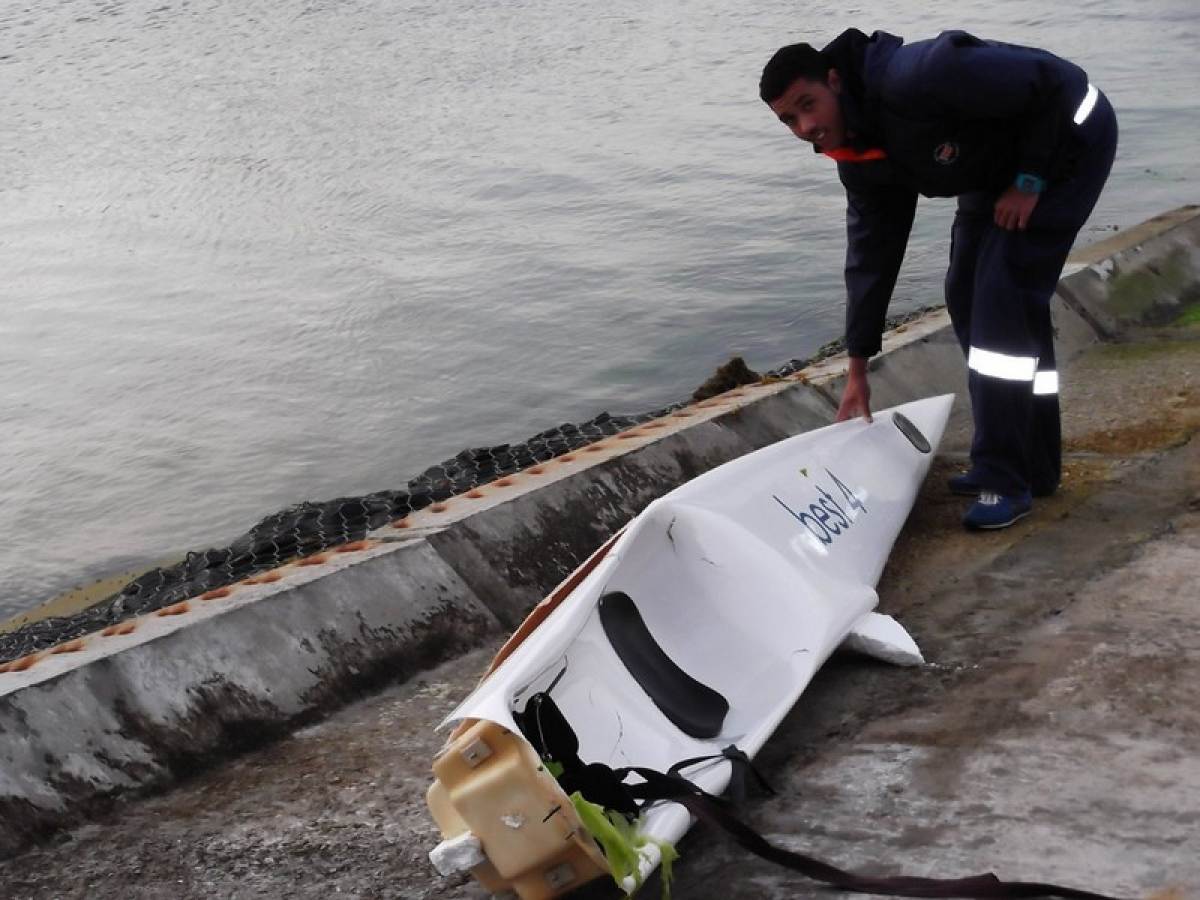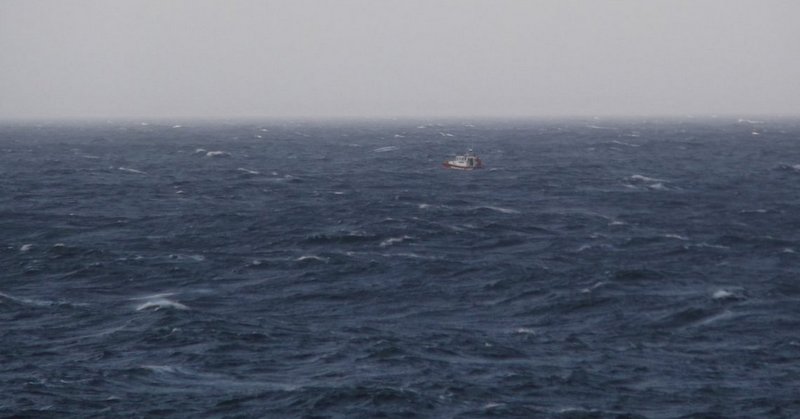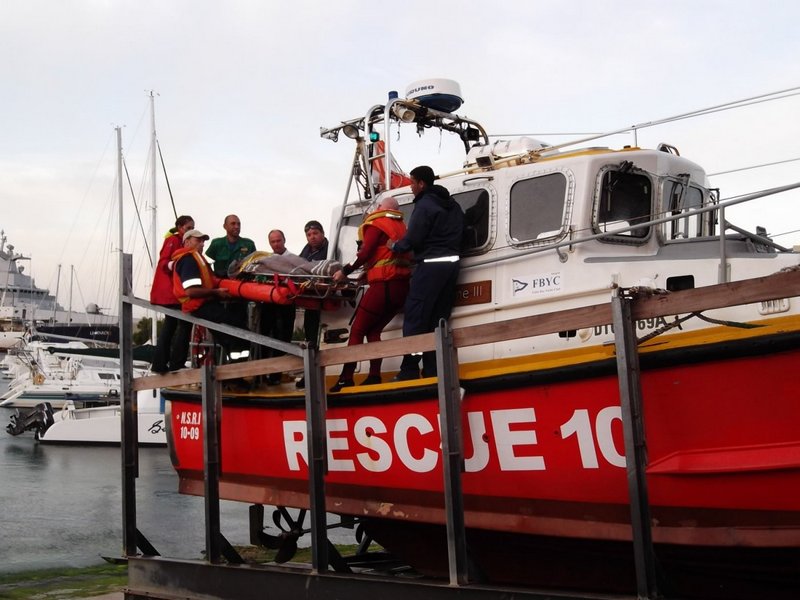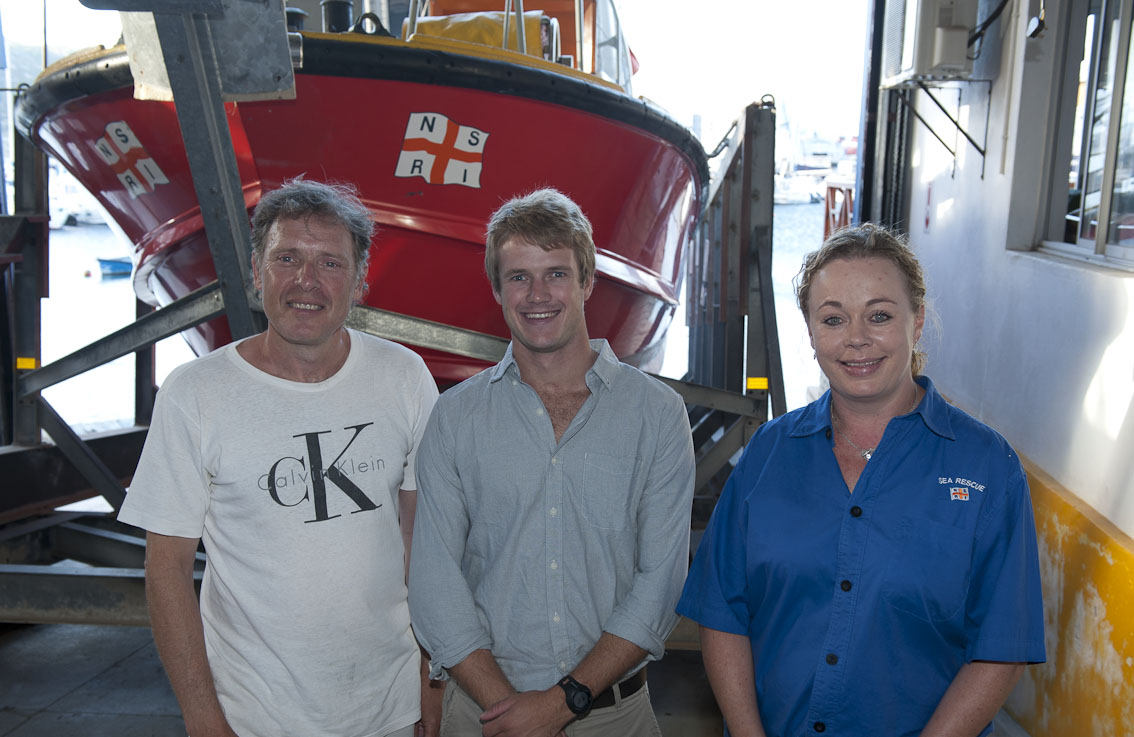Surfski Rescue - Total Annihilation
 Dave Black's Surfski - destroyed...
Credits: NSRI Station 10 - Simon's Town
Dave Black's Surfski - destroyed...
Credits: NSRI Station 10 - Simon's Town
Editor: The conditions were clearly extreme: 40kt SE and 3.5m swell. But no-one could have foreseen that a breaking wave would smash Dave Black's surfski so hard that it would disintegrate, leaving him swimming in the maelstrom... Luckily he had his mobile phone with him and this lead ultimately to his rescue by the Simon's Town NSRI crew. This story dates from 2012, but with the increase in the number of surfski paddlers worldwide, and the ever lighter constructions being used in surfski manufacture, this story is more relevant than ever.
In Dave's own words:
On Thursday, 13th December 2012, I endured a particularly harrowing experience - my surf ski broke in half on a big Millers downwind run in Cape Town in pretty extreme conditions: a 3.5m SE swell and 40-50 knot SE wind. Even though I was in constant mobile phone contact with the NSRI (National Sea Rescue Institute),it took the NSRI almost an hour to locate me in the rough sea conditions, by which point my body temperature had dropped to 32C, approaching severe hypothermia.

The NSRI's search and rescue vessel Spirit of SafMarine III, searches for Dave Black
Treading water with a waterlogged tail section, 1km offshore in cold, rough conditions is a scary experience, which I highly recommend everyone try and avoid.
Clearly, I was incredibly lucky, both to have carried a mobile phone, and to have had an NSRI base close at hand.
By writing this, I hope that fellow paddlers can learn from my experience, and err on the side of precaution in the future: always carry a mobile phone, with important numbers saved; take flares; don't paddle in conditions out of your depth; and stay in pairs or groups where necessary. You can't influence uncertainty, but you can reduce risk with some simple forethought and precautions.

Dave Black is carried off the NSRI's Spirit of SafMarine III at the Simon's Town base
Freak Accident
While most might attribute problems at sea to lack of ability, what happened on Thursday was definitely a freak incident, one that could literally happen to anyone. I have been paddling for 6 years, and consider myself to be a pretty experienced and competent paddler (2010 Cape Point Challenge, 4 Cape Surf Ski Series, 5 Fish River Canoe Marathons, 2010 Dusi, and plenty of other river races). I am fit, and have been training for the 2012 Cape Point Challenge for the past 3 months. In addition, the boat I was paddling (Fenn Mako Elite), was only 3 years old, and in very good condition.
I have never had any issues with it, and generally inspect it on a regular basis. I had a Garmin GPS watch on me at the time, and so was able to record events fairly accurately. Below is a detailed log of Thursday's events
Millers Rescue Timeline

| Time | |
|---|---|
| 5:35pm | Left Millers Point Slipway |
| 5:44pm | Turned to face downwind at rock off Millers Point |
| 6:00pm | Open-ocean wave broke on to starboard side of surfski, coming from aft quarter, splitting seams, and tearing hull. Boat immediately waterlogged, floating aided only by foam stringer. Just over 1km offshore of Murdock Valley (to the south of Simonstown). This happened 3km from starting point off Miller's Point. Stayed with waterlogged ski. This offered no buoyancy, but would be more visible than without. |
| 6:01pm | Dialled NSRI Table Bay base (did not have Simonstown station number saved on phone). |
| 6:02pm | Contacted by Simonstown NSRI base, gave location and situation ("1-2km's off Boulders"). Constant contact with NSRI Simonstown base from this point onwards. |
| 6:15pm | (roughly): Contacted by NRSI Simonstown. NSRI boats, Eddie Beaumont II and Spirit of SAFMarine III launched for rescue. |
| 6:30pm | (roughly): From combination of wind and swell, surf ski tore in half just forward of foot well. Front half of surf ski blew away. From this point onwards, hung on to waterlogged tail of boat (from foot well aft). Again, this offered no buoyancy, but would be more visible on surface than without. Roughly 1.3km's offshore at this stage. |
| 6:40pm | (roughly): Spotted Spirit of SAFMarine III roughly 400 metres to the south of my position. Spirit of SAFMarine III did not see me. |
| 6:50pm | (roughly): Sun began to dip behind mountains above Simonstown. Under the shadow of the mountain, my chances of being found would diminish rapidly. |
| 6:51pm | Rescued by Spirit of SAFMarine III, 1.5km's offshore of Simonstown Golf Course, having drifted 1.6km's in just 51 minutes. Body temperature was down to 32C (30C is the temperature below which the body begins to shut down). Wrapped in heavy blankets to regain body temperature. |
| 7:29pm | Reached NSRI Simonstown base. Transferred from Spirit of SAFMarine III to ambulance. Transported in ambulance to Constantiaberg Mediclinic, to regain body temperature and to check for fluid in lungs. 'Secondary drowning' from fluid in lungs is apparently a common occurrence. |
| 8:24pm | Reached Constantiaberg Mediclinic. |
| 9:34pm | Discharged from Constantiaberg Mediclinic: body temperature back to normal (37C), and no sign of fluid in lungs. |
Could I have swum to shore?
I have been asked this question a lot. Because I had a mobile phone, the obvious choice for me was to contact NSRI immediately, and stay with my boat (although severely waterlogged), providing greater surface visibility.
Treading water in the rough seas, wind and spray, it is also very difficult to accurately estimate your position relative to the shore - from what I could see, I could have been anything from 1 to 3km's offshore.
If one were to have swum
- Given Thursday's conditions, and being just over 1km offshore (from GPS data), it would have taken a strong swimmer roughly 50 minutes to get to shore, with the additional physical exertion obviously delaying the onset of hyperthermia.
- The big trade off is once swimming, the chances of being rescued by boat are very near to impossible, especially in the shadow of the mountain (or worse, after sunset).
- Although I am not swimming fit, I do consider myself to be a capable swimmer. I might have made it to shore, however, only if I started swimming in the very beginning, while my body temperature was still close to normal. I surely would not have made it if I tried to swim after treading water for any length of time.
What I learnt from Thursday
- NEVER take NSRI's services for granted - you never know when you might need their help. The NSRI is almost solely comprised of willing and competent volunteers and relies on donations. If you happen to use the sea, there is always a chance you could find yourself in trouble and it may be best to pay your way forward and support them/donate, however small. Go to www.nsri.org.za for details.
- Avoid paddling in conditions that are beyond your ability.
- Lucky as I was to have a mobile phone on me, the combination of a mobile phone and flares (both pencil and a smoke signal) would have made NSRI's rescue considerably easier, dramatically shortening my time spent in the water. You don't want to be in a situation where your only option is to swim - you never know how far offshore you might find yourself.
- Thursday's conditions were wild. I was not out there to break records - I could have benefitted greatly from pairing up with someone of a similar ability.
- Prepare for the unexpected: check boat thoroughly before paddling in testing conditions. Again, take a mobile phone, flares, and wear bright clothing.
Two massive Thank You's
I owe a massive debt of gratitude to both the NSRI and Derrick Goldman of Paddler's Kayak Shop in Simonstown (www.paddlers.co.za), who got fully involved from his home veranda and spotted me through his spotting telescope, managing to direct the NSRI boats towards me.
I am one lucky paddler - The combination of having a mobile, Derrick and the NSRI saved my life.
A huge thank you also needs to go to my family, girlfriend Kate Goss, Mark Smith, Tom Schilperoort, Justin Maddock, Fenn Kayaks, and everyone else who has been incredibly supportive. Please take what I have learnt from this situation seriously and enjoy your paddling as much as I do. Hope to see you on the water.
Editor's notes
- Lest anyone think that Dave was on his own on that wild day, there were approximately 30 paddlers out at the time.
- Dave was using a PFD, had his mobile with him (obviously) and was leashed to his surfski.
- In the last couple of years, the SafeTrx app has become standard for the regulars doing downwinds in South Africa. If it had been available and Dave had been using it, this rescue would have been much quicker.
- After a dramatic rescue incident also in Cape Town, in 2006, race organiser Billy Harker initiated a scheme where hundreds of paddlers regularly donate each month - this ongoing financial support has resulted in a number of RIBs being provided for NSRI stations country-wide.

David Black (centre) with Derek Goldman (left) who spotted him in the wild sea and directed the Sea Rescue boat to him. On the right is Yvette du Preez who talked to David via cell phone throughout his ordeal.

